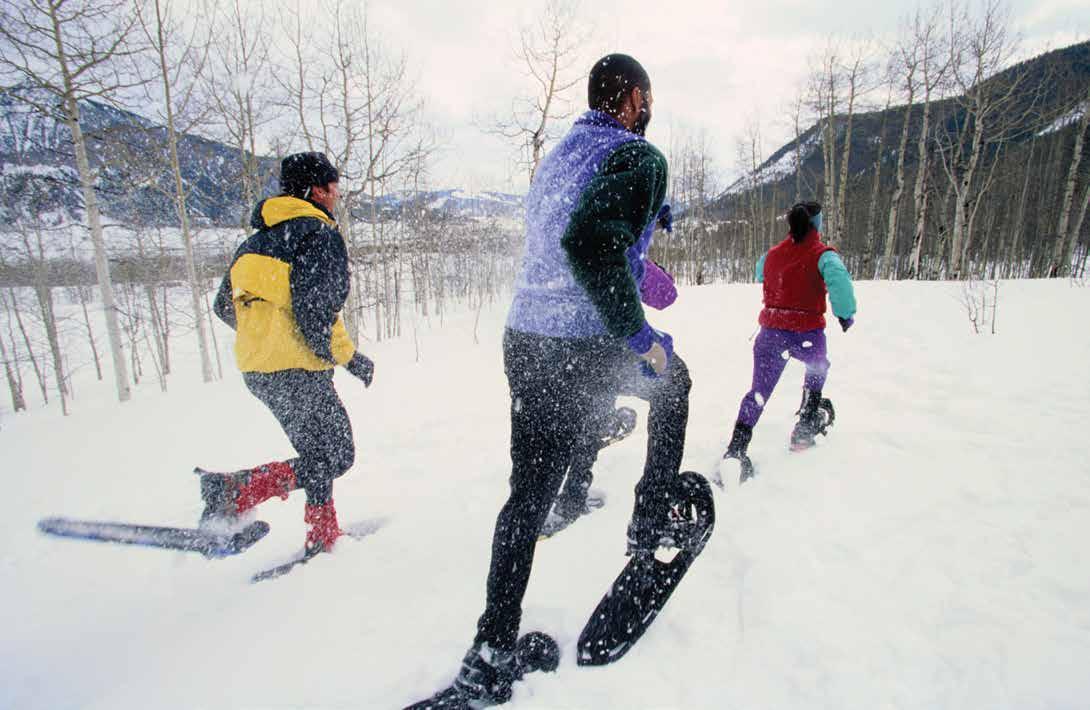
4 minute read
SNOWSHOEING
Snowshoeing: great exercise in a heartbeat
By Rick Hellard
Advertisement
Iused to consider myself reasonably fit.
I’m a nut for many cardiovascular endurance-based sports, like swimming, cycling, running and cross-country skiing. I dabble in paddling and adventure racing. I’ve trained and raced for 21 years to prepare for six Ironman triathlons, 150-plus triathlons, a zillion five and 10k running races, 12 marathons, a few Keskinada 50k’s, the Lake Placid 50k Loppet, and more.
In the wake of all this competitive toil, I was looking for new outdoor activities that would be enjoyable, yet physically demanding.
So, I tried snowshoeing.
My first experience early in the winter of 2000 was humbling. It had
just snowed about 30 cm and my Atlas snowshoes were beckoning from the closet. Those visions of powering through knee-deep snow, however, gave way to wheezing and panting like I’ve rarely experienced! A glance at my watch was shocking—I was just five minutes out. I’d found an activity that pushed the limits of my fitness in a heartbeat— pun intended.
The next few months revealed that snowshoeing is an incredible activity that can be done almost anywhere by anyone. It works in rural, wide-open spaces and it works in inner-city green spaces. It can also be a very social activity.
A very basic level of technique is all that’s required if you just want to get out and enjoy the season. A good level of fitness is still helpful, but not essential. If you want to go quickly, however, it helps to be very fit.
I have since discovered an entire network of trails in the Lac Philippe sector of Gatineau Park, just a few kilometres from Ottawa in Quebec. I found Carman Trails, trail 57 and Brown’s Cabin, 55, 54 and the Lusk Caves, 53 and 52. All were great challenges and very beautiful. The trail from Carman Trails (P15) to Herridge Lodge is one of my favorites.
Remember, though, you have to get back, too. This particular trail has a rest stop with fireplace and benches about halfway. On a nice day, it’s about a 90-minute trip in each direction. Another great trail is along the north side of Lac Philippe. It has two rest stops with fire pits and benches. This trail also takes about 90 minutes each way. It pops out at the intersection of trail 50 and 54, the trailhead to the Lusk Caves. Returning to P19 can be done either on the 50 or the 54. Trail 50 is considerably easier along the lake. If you’re feeling energetic, trail 54 is

tougher, but worth the effort. On a nice day, trail 54 takes about 90 minutes each way, too.
The National Capital Commission has maps of the trails. You’re allowed to snowshoe on all trails, but be conscious of, and courteous to, Nordic skiers who may be coming on the trails. Stay in single file on ski trails to let the fastermoving traffic pass.
Into the starting gate
If you’re inclined to try snowshoeing, it helps to start off on the right foot. In the beginning, if you do not have snowshoes, you may wish to drop by one of the outdoor specialty retailers and check them out. Make sure the staff person you buy from is knowledgeable and takes part in the activity themselves. You can also rent from many of the local establishments so you can ‘test walk’ your potential choice of shoe.
Once you have your snowshoes and clothing, you’re all set to go. It’s a good idea to choose an easier trail for your first outing, and look for a path with packed snow. This will foreshadow how the bindings work best on your boots. On my first day, I learned that hitting your anklebone with the opposite snowshoe is really quite painful—and even more so the third time. If I were to re-learn snowshoeing, I’d only hit my ankle once.
I’ve found these tips useful for venturing out on snowshoes: • Buy properly fitting, good quality snowshoes suited to your level from someone
Photo by Nancy Lee Photo by National Capital Commission
who uses snowshoes themselves. • When dressing for your outing, you should not be warm at the outset; you should be a little chilled (even cold) for the first five or 10 minutes. You’ll warm-up quickly, but if you dress too warmly, you’ll overheat, sweat, and then feel really chilled. • Running or cross-country ski clothing works best, but trekking or hiking clothing will do just fine. • Avoid cotton and wear your clothing in layers—synthetics like Dryline (Brooks, Hind, Saucony) or Dry-Tex (Louis Garneau) work very well. • Waterproof footwear is strongly suggested; insulated footwear is optional. • Use gaiters to keep the snow out of your boots. • Bring water and food, and make sure it doesn’t freeze. • Poles are helpful in deep snow or on tougher terrain. • Respect the environment and have fun!
I have found snowshoeing to be a great replacement for some of my regular runs, rides and skis. I like to get out once or twice weekly and have found that no matter how cold it is, snowshoeing always warms me up quickly.
Give snowshoeing a try. You could discover a whole new version of a winter wonderland you never knew existed.
—Rick Hellard has been competing in running, cycling, triathlon and cross-country ski races for more than 21 years. The owner of Zone3sports: Multi-Sport Training Programs, he is also a snowshoe racer, undefeated in three years. Hmmm, is that a challenge Rick? :)









